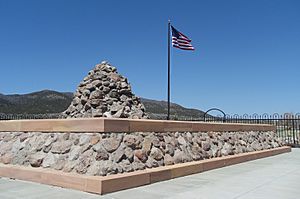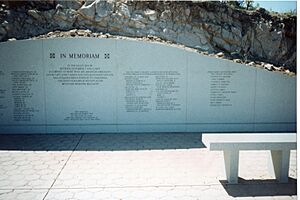Mountain Meadows Massacre facts for kids
Quick facts for kids Mountain Meadows Massacre |
|
|---|---|
| Location | Mountain Meadows, Utah Territory, United States |
| Date | September 7–11, 1857 |
| Target | Members of the Baker–Fancher wagon train |
|
Attack type
|
Mass murder |
| Weapons | Guns, Bowie knives |
| Deaths | 120–140 members of the Baker–Fancher wagon train |
|
Non-fatal injuries
|
Around 17 |
| Assailants |
|
| Motive |
|
The Mountain Meadows Massacre was a terrible event that happened in September 1857. It was a series of attacks during a time called the Utah War. This event led to the killing of at least 120 people from a group traveling by wagon train called the Baker–Fancher party.
The massacre took place in southern Utah Territory at a spot called Mountain Meadows. The attacks were carried out by local settlers who were part of the Utah Territorial Militia, also known as the Nauvoo Legion. Some Southern Paiute Native Americans also joined them. The Baker–Fancher group was made up mostly of families from Arkansas. They were on their way to California, following a path called the Old Spanish Trail.
Contents
What Led to the Massacre?
When the Baker–Fancher party reached Salt Lake City, they continued south along the Mormon Road. They eventually stopped to rest at Mountain Meadows. At this time, there were many rumors about how the travelers were acting towards the local Mormon settlers.
People in the area were also very worried about a possible invasion. This was because President Buchanan had sent a military group to Utah. In response, Brigham Young, the leader of the Mormon community, declared martial law. This meant that the military was in charge, and people were very tense.
While the travelers were camped, local militia leaders, including Isaac C. Haight and John D. Lee, planned to attack the wagon train. They wanted it to look like Native Americans were responsible. So, they convinced some Southern Paiutes to join a larger group of militiamen who were dressed like Native Americans.
The Attack and Siege
The militia's first attack on the wagon train was met with resistance. The travelers fought back bravely, and a five-day standoff began. During this time, the attackers surrounded the wagon train.
As the siege continued, the militia leaders grew worried. They feared that some of the travelers had seen the white men among the attackers. This would reveal that the main attackers were not just Native Americans. Because of this, the militia commander, William H. Dame, ordered his forces to kill the travelers.
The travelers were running low on water and food. Some militia members approached them under a white flag, which is a sign of peace. They promised the travelers safety. The travelers gave up their weapons and were escorted away from their camp.
However, after walking a short distance, the militiamen, along with other hidden forces, attacked the travelers. They killed all the adults and older children. Only seventeen young children, all under the age of seven, were spared.
After the Massacre
After the terrible event, the attackers tried to bury some of the bodies. But most of the remains were left exposed to wild animals and the weather. Local families took in the surviving children. Many of the victims' belongings and animals were sold off.
Investigations into the massacre were delayed by the American Civil War. In 1874, nine people were accused of crimes related to the massacre. Of these, only John D. Lee was put on trial. After two trials in the Utah Territory, Lee was found guilty. He was sentenced to death and executed by a firing squad on March 23, 1877.
Historians believe the massacre happened because of several reasons. These include the widespread fear of an invasion and certain Mormon teachings against outsiders during a period called the Mormon Reformation. Experts still discuss whether senior Mormon leaders, like Brigham Young, directly ordered the massacre, or if only the local leaders in southern Utah were responsible.
Remembering the Mountain Meadows Massacre
People have built several monuments to remember the victims of the Mountain Meadows Massacre.
The first monument was built just two years after the event by Major Carleton and the U.S. Army. It was a simple pile of stones over the graves of 34 victims, topped with a large cedar cross. This monument was later destroyed but rebuilt by the U.S. Army in 1864.
In 1932, local residents built a memorial wall around what was left of the monument.
Starting in 1988, a group called the Mountain Meadows Association began working on a new monument. This group includes descendants of both the victims and the Mormon participants. The new monument was finished in 1990 and is cared for by the Utah State Division of Parks and Recreation.
In 1999, The Church of Jesus Christ of Latter-day Saints (LDS Church) replaced the earlier monuments with a second monument, which they now maintain.
In 1955, a monument was placed in the town square of Harrison, Arkansas, to honor the victims. It has a map and a summary of the massacre, along with a list of the victims' names. In 2005, a copy of the original 1859 U.S. Army monument was built in Carrollton, Arkansas.
In 2007, a ceremony was held at Mountain Meadows to mark 150 years since the massacre. About 400 people attended, including many descendants of those who died.
In 2011, the site was named a National Historic Landmark. This happened thanks to the efforts of both the victims' descendants and the LDS Church.
Images for kids
See also
 In Spanish: Masacre de Mountain Meadows para niños
In Spanish: Masacre de Mountain Meadows para niños





